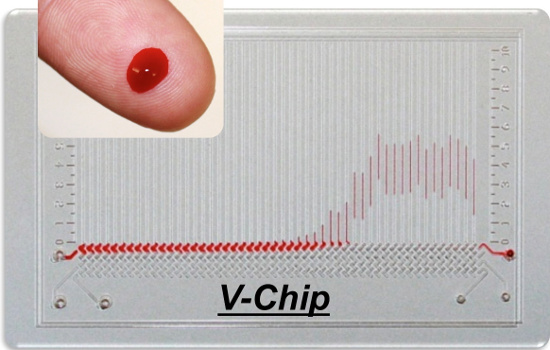Ultra-fast blood tests with new equipment
Scientists at Methodist Hospital Research Institute and MD Anderson Cancer Center have developed a new device the size of a business card that can allow doctors to check insulin, blood proteins, cholesterol , and even signs of viral or bacterial infection at the same time with a drop of blood. This invention was announced Wednesday by Nature Communications.
>>>Quick and accurate blood tests with SpinChip
This device - called V-Chip - allows tests to be carried out at the bedside and even in remote areas. V-Chip gives accurate results, is cheap, and can be portable. It only needs one drop of blood and can do 50 different tests in one turn. Such tests are usually performed using large, heavy, complex devices, or require fluorescence analysis, and must also be performed in a laboratory. V-chip, on the other hand, can be pocketed and carried around.

V-chip blood test device only needs a drop of blood.
It consists of two thin pieces of glass, about 5x7cm. In the middle are chambers containing four things: (1) hydrogen peroxide, (2) 50 antibodies to each individual protein, DNA or RNA fragments, or lipid, and catalase enzymes, (3) serum or other samples , and (4) a dye. Initially, the compartments are kept separate. A change in the glass panels makes the chambers come in contact with each other, creating a zigzag-like space from one end to the other of the V-chip.
When a substance needs to know, insulin, for example, sticks to antibodies on the glass plate, catalase activates and splits nearby hydrogen peroxide into water and oxygen. This approach is called ELISA, or enzyme-linked immunosorbent assay. Oxygen pushes the dye onto the columns. The more insulin present, the more oxygen is produced, and the dye is pushed to the farther slots.
Tests show that the distance is proportional to the amount of substrate present - in this example insulin. The end result is a visual bar chart that is very accurate and easy to read. Dr Lidong Qin, a member of the research group, said: "Our next steps are to make devices simpler and more user-friendly."
- What blood tests can you know about?
- Things to know about general blood tests
- Equipment tiny blood tests under the skin
- Quick and accurate blood tests with SpinChip
- The US fabricated cancer detection equipment for only 20,000 VND
- The device detects blood poisoning
- Video: Watch the laser light move
- Blood tests can detect Alzheimer's disease
- Blood tests help detect Alzheimer's disease
- Successfully developed a new blood test
- Blood test method helps detect cancer 5 years early
- Clinical significance index of medical tests
 Daily use inventions come from universities
Daily use inventions come from universities Special weight loss device helps prevent appetite
Special weight loss device helps prevent appetite 8 inventors were killed by their own inventions
8 inventors were killed by their own inventions Iran invented a motor car powered by water
Iran invented a motor car powered by water